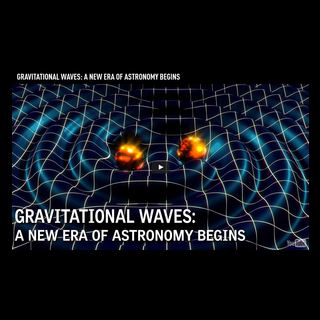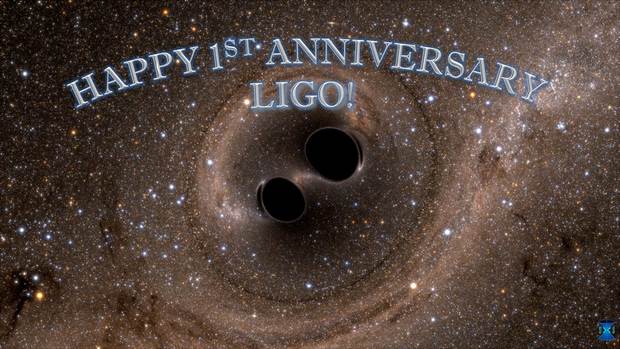
This image shows a simulation (based on the actual parameters of the system LIGO detected) of what the two orbiting and then merging black holes detected by LIGO on September 14, 2015 might have looked like to a 'nearby' observer prior to their merger. Note the warping of space around the two objects, causing the light from more distant stars to appear distorted. Today, LIGO celebrates the first anniversary of its historic discovery!
LIGO Celebrates First Anniversary of Historic Gravitational Wave Detection!
Feature Story • September 14, 2016
By Kimberly Burtnyk
"Ladies and gentlemen. We…. have detected…. gravitational waves! We did it!"
And so, with those carefully paced words, on February 11, 2016 Dr. David Reitze, LIGO Executive Director announced to the world one of the most remarkable scientific accomplishments in 100 years.
Immediately, the National Press Club in Washington DC, packed to the rafters with media from around the globe, erupted in thunderous applause, acknowledging the importance and weight of the long-awaited discovery. This scene of revelry and excitement was played out in dozens of locations around the world where LIGO and Virgo staff, scientists, and engineers eagerly watched the press conference streaming live over the internet.
The ovation in the press club was fueled largely by the excitement of witnessing history in the making (the media had learned of the discovery just hours before the announcement), but the rousing cheers buffeting auditorium walls at LIGO’s Hanford and Livingston observatories, at Caltech and MIT, and many other institutions around the world, were fueled by enormous pride and a great sense of relief! Finally, LIGO’s secret was out and we could all openly talk about our momentous discovery.
While the world learned of the detection on that February morning, almost every member of the LIGO scientific collaboration (LSC) knew about it the day it happened: September 14, 2015. Exactly one year ago today.
A Historic Anniversary
There is little doubt that September 14, 2015 will go down in scientific history. It was the day that one of the most intriguing predictions of Einstein’s General Relativity morphed from theory into reality. It was the day on which an entirely new field of scientific inquiry, gravitational wave astronomy, was born. And it was the day that human beings acquired a new sense, a completely new way of observing and learning about the universe unlike anything that has existed before.
Many “firsts” occurred on that day: the first detection of gravitational waves, the first direct observation of black holes, the first confirmation that binary black holes exist in the universe, etc. The detection even occurred during the first week of the first observing run of the new “advanced” LIGO detectors. Detecting gravitational waves that early in LIGO’s operation was hoped for but never guaranteed. Moreover, detecting a signal as 'loud' and obvious as the first one was, was nothing short of shocking.
Looking back, the past year has been a whirlwind of discovery and analysis. So today is a good day for us to reflect on this discovery and how lucky we all were to have been present at the observatories on the day that scientific history was made.
Witnessing History in the Making
For most LIGO staff, news of “The Event” (as it came to be known early on) came from an email with the subject, “Very interesting event on ER8”. It read as follows:
Date: September 14, 2015
12:54 p.m. CEST (3:54 a.m. Pacific)
“Hi all,
cWB has put on gracedb a very interesting event in the last hour. … It is not flagged as a hardware injection, as we understand after some fast investigation. Can someone confirm it is not a hardware injection?”
Attached to the email were the first ever pictures of a real gravitational wave signal as seen by LIGO’s twin observatories. The images, generated within minutes of the arrival of the wave, show a distinct upward-curve, the shape and color of which are defined by the duration of its passage, the frequency of the wave, and the intensity of the energy represented. The signal arrived first at LIGO Livingston, then 7 milliseconds later, it shook the Hanford interferometer. While Livingston 'heard' the signal first, Hanford's interferometer was performing a bit more quietly and so that signal appears more prominent against the background noise. Consequently, Livingston likes to say "we heard it first", but Hanford can counter with, "we heard it better!"
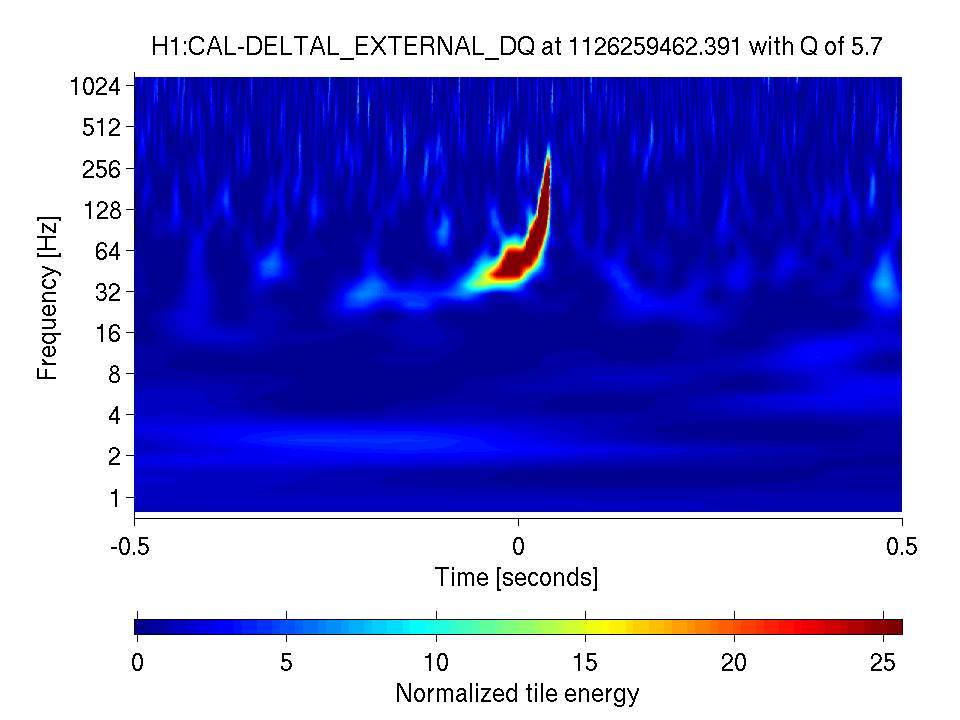
Hanford detected the historic gravitational wave signal 7 milliseconds after Livingston, but the Hanford signal was more prominent. Hanford's interferometer was more sensitive than Livingston at the time of the detection.
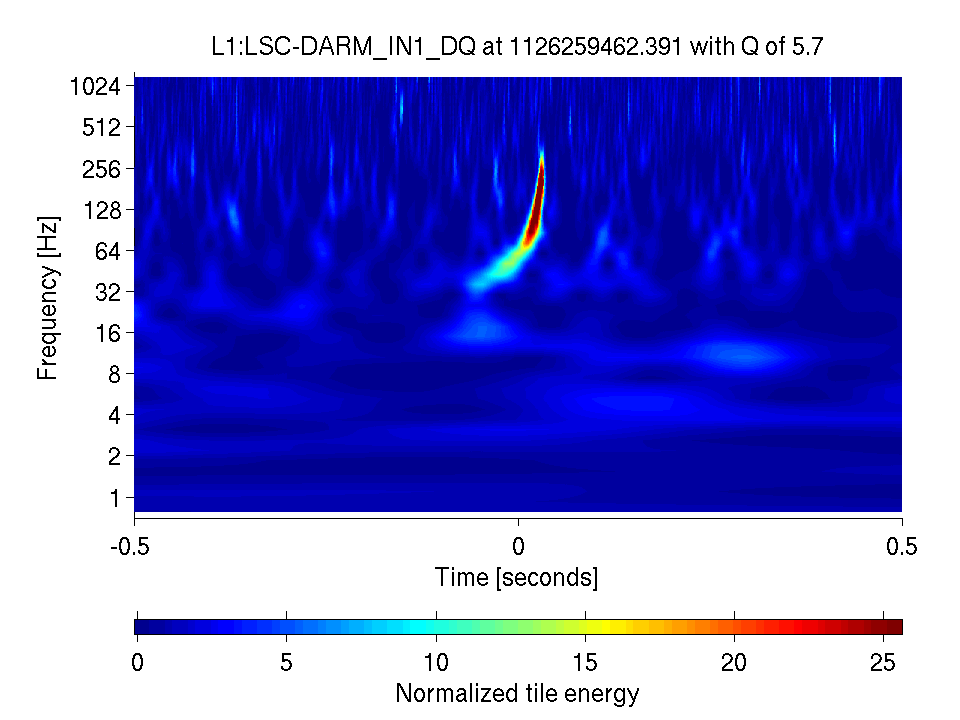
LIGO Livingston Observatory made history by being the first detector to sense the passage of a gravitational wave. Traveling at the speed of light, the signal took 7 milliseconds to reach LIGO Hanford Observatory.
The shape of the curve is the unmistakable signature of the rippling of spacetime itself as experienced by the two interferometers. Though we didn’t know it yet, this magnificent space-shudder was caused by the most violent and powerful astronomical event ever observed in the universe: the cataclysmic merging of two surprisingly massive black holes.
Within hours of the detection, the LIGO detection analysis team was off and running. As LIGO staff awoke to the news of a possible detection, dozens of reports began appearing on the LIGO “Event Logbook” as scientists and engineers quickly performed their appointed analysis tasks, checking the performance of the interferometers, looking for odd ‘noise’ sources that could have produced the signal, measuring the strength of the signal, looking for anything local to the observatories that might have generated the signal, and a host of other checks and balances that needed to be looked at immediately to ensure that the signal wasn’t caused by some obvious Earth-bound source.
A day or two later, another visually stunning graph was posted on the Logbook, showing how much the arms of LIGO’s Hanford (H1) and Livingston (L1) interferometers lengthened and shrunk as the wave passed. This “waveform” has become iconic within the LSC for illustrating the remarkable agreement between the Hanford and Livingston interferometers (separated by 3000 km) as they responded to the same gravitational wave washing over, or rather, through the Earth.
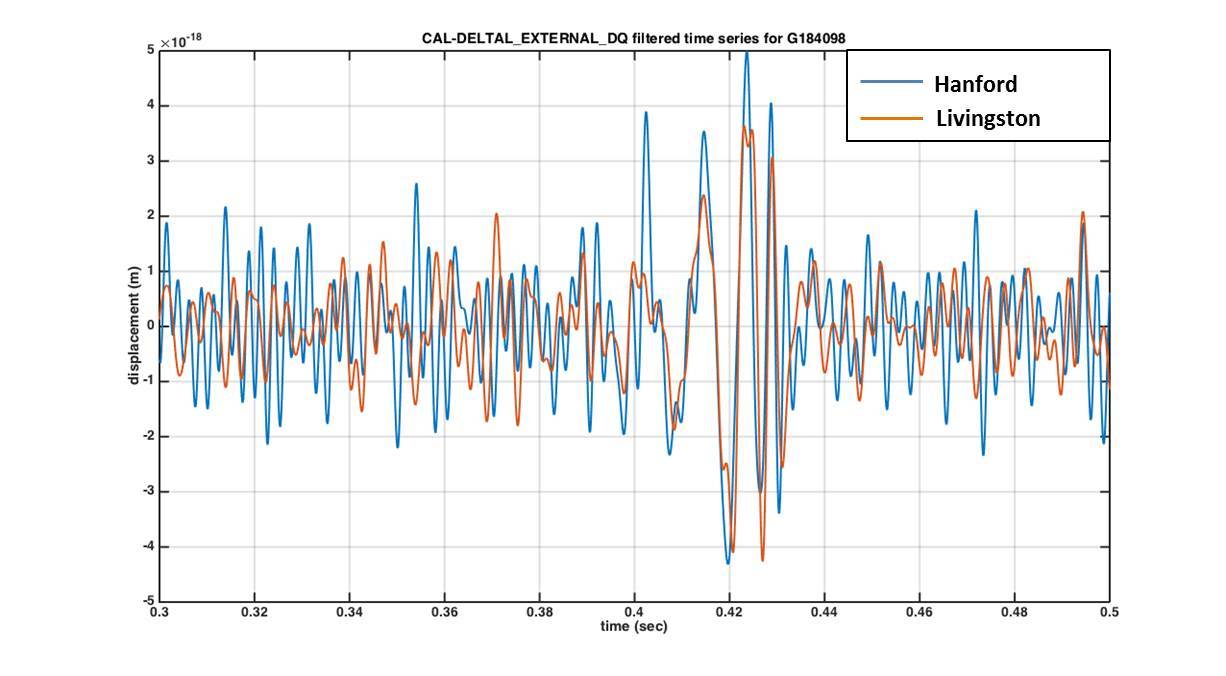
Shape of first detection 'waveform'. The blue line shows the stretching and shrinking of the Hanford Observatory's arms, and the orange line shows how Livingston’s arms responded in the presence of the gravitational wave. The taller the line, the more stretching/shrinking the arms experienced. The scale on the vertical axis (10 -18 meters) reveals that for this detection, LIGO measured movement 4000-5000 times SMALLER than a proton!
On the morning of the detection, staff working at the actual observatory sites received an email asking them to report where they were and what they were doing between 1:50 and 3:50 a.m. PST (3:50 and 5:50 a.m. CST)—around the time the wave passed through the interferometers. Some weeks prior, we’d received a similar email as practice, intended to identify whether any human movements at the sites could have caused the interferometer to ‘jiggle’ in a way that looked like a gravitational wave jiggle, should we detect one. The last time that email was sent out, it was just a test. This time, it was the real thing.
Still more quick analyses were conducted in rapid succession. Within 4 days, the signal was converted into an audible ‘chirp’ (created by converting the frequency of the flicker of light into a corresponding sound). When the chirp from the signal was compared to mathematically accurate simulations made years before, the similarity between them was heart-stopping. For many, hearing the chirp for the first time was the most goosebump-inducing moment of the entire first-detection adventure.
Below you can listen to the 'chirp' of the event. The sound was made by converting the flickering light signal from the interferometers' lasers into a sound. In the first two runs, the frequencies of the sound-wave exactly match the frequencies at which the mirrors moved with the passage of the gravitational wave. The second two runs repeat the sounds but at higher frequencies making it easier to discern.
Too Good to be True?
Looking back, it’s easy to see why so many people got so excited so quickly: the early-morning timing, the textbook signature, the beautiful chirp. Others, however, thought it was too perfect; just too good to be true. And so in the immediate aftermath, some healthy skepticism and incredulity dogged the authenticity of the signal. Lots of chatter passed from one office to another, hushed conversations, closed office doors, cryptic emails…people asking each other, “is this for real?!” LIGO was built to detect gravitational waves, and when it finally did so clearly and beautifully, it seemed almost inconceivable!
By September 18th, most everyone believed that, barring the occurrence of some unknown glitch or evil genius hacking into its systems, LIGO’s interferometers had nabbed their first gravitational wave. Scientific history had been made, and a more-than-50-year human quest to detect gravitational waves was realized. Coincidentally, it happened almost exactly 100 years after Einstein published his theory of General Relativity (published in November, 1915), in which gravitational waves were predicted. Einstein himself never believed that gravitational waves would be detectable because of how small their effects would be here on Earth.
Of course, believing the signal was real and proving it was real were two different things, and despite the initial confidence, some genuine fear lingered that deeper investigation would reveal that the signal wasn’t real after all.
Extraordinary Claims Require Extraordinary Evidence
As soon as word was out about the detection, all LIGO, LSC, and Virgo staff were sworn to secrecy so LIGO and Virgo scientists and engineers could scrutinize the data and try to confirm, beyond a shadow of a doubt, that we had detected the fleeting, ephemeral vibrations of spacetime generated by a cataclysmic cosmic event, and not something caused by some Earth-based natural phenomena or human activities. Then, and only then, would the world be informed.
This imposed silence was critical to the verification process. Too many times in history, scientific claims have been made public prematurely, only later to be discredited, much to the embarrassment of the scientists and institutions involved. LIGO wanted to be 100% certain of its conclusions, but doing so would take time.
In the 5-month period between detection and announcement, hundreds of people across the LIGO-Virgo collaboration devoted thousands of hours checking every last bit of data. Every computer code, every measurement, every calculation, every potential non-cosmic explanation for the coincident signal, including a ‘rogue’ or ‘malicious injection’—a case where someone somewhere, somehow hacked into LIGO’s systems and faked the signal—was checked, double checked, and then checked again. One by one, the pieces came together, and the final picture was emerging.
By early to mid-October, LIGO scientists had ruled out the possibilities that the signals at both sites were caused by an instrument ‘glitch’, an astoundingly coincidental terrestrial source, or by someone with the will and the way to fool over 1000 scientists. Software analysts had finished reviewing software codes and confirmed that nothing untoward had happened. Finally, confirmation that the source was indeed of astrophysical origin came when LIGO engineers completed a ‘correlation and coupling’ analysis of the interferometers’ 200,000 or so instrument sensors. Within 3 or 4 weeks of the signal’s arrival, the odds that it was not a gravitational wave from deep space had dissolved into oblivion; there could be no other explanation:
The signal was real, and LIGO had achieved the (once, thought) “impossible”.
Black Holes and Spacetime Warps
Confident that the signal was real, LIGO researchers then set out to understand what generated the waves. That information could be found within the signal itself. It turns out that the ‘waveform’ contains all of the sought-after information. We would just have to decipher it.
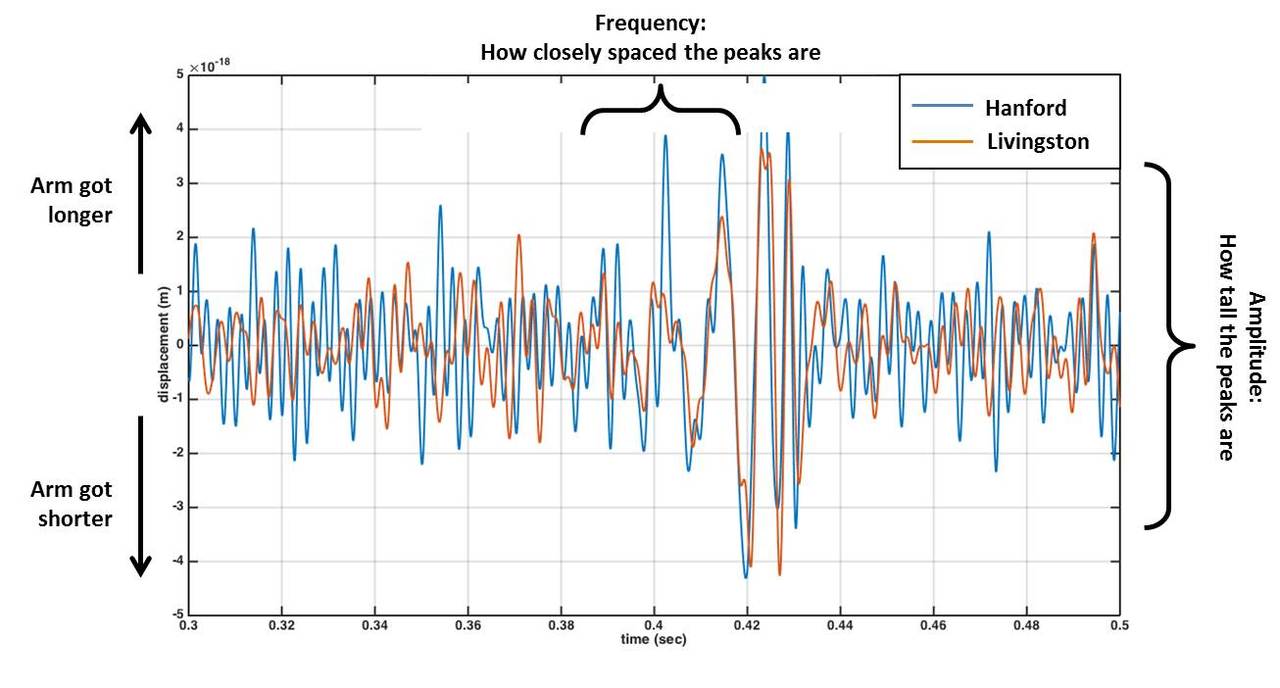
Overlay of Hanford and Livingston signal ‘waveforms’ illustrating the meanings of frequency and amplitude in the gravitational wave signal.
First, the overall shape of the signal reveals that the waves were caused by the merger of two massive objects orbiting each other—a “binary system”. As the objects got closer and closer, the amplitude (height) of the waves got bigger and bigger, causing the arms of the interferometers to grow and shrink more and more over time as the wave passed (this is first noticeably detected at around 0.41 seconds in the timeseries at right). Shortly after the two objects merged into one, the waves suddenly died down (about 2-hundredths of a second later!), and in turn, the vibrations inside the arms settled down (where the heights of the lines get shorter again). This pattern is indicative of two enormously dense objects orbiting each other, and then merging, causing big waves in space-time.
Second, the frequency of the signal (how closely spaced the peaks are) told us that we had detected a binary black hole system: the lower the frequency of the signal, the heavier the objects that merged. Looking at the signal's frequency, we knew that only something as heavy as black holes orbiting each other could generate a waveform with the frequency of the one we detected.
In the weeks that followed, more questions were asked and then answered: How big were the black holes? How far away were they when they merged? How much energy did they give off when they merged? How fast and in what direction were they spinning before they merged? What were the properties of the final black hole produced by the merger? Luckily, since every orbiting pair of black holes is unique, each merger of black holes creates a unique gravitational wave signal, like a fingerprint, that depends on the properties of the black holes doing the merging.

LIGO’s method for determining the masses of the black holes that generated the detected gravitational waves is a lot like fitting the right shape into the right hole of this shape-sorter toy
By comparing the waveform of the signal we received to a large set of approximations, or 'templates' of possible gravitational wave signals, we were able to roughly estimate the masses of the black holes. It’s a process not unlike using a ‘shape-sorter ball’ (figure at left)--a toy that so many toddlers have enjoyed over the decades--just thousands of times more sophisticated.
Instead of trying to match 10 shapes with 10 cutouts in a ball, LIGO analysts had to try and match one shape (our waveform) with one of 200-thousand cutouts (‘templates’)! A first round of matching revealed that the black hole masses had to lie somewhere between 20 and 40 times that of the Sun. Armed with that estimate, a second round of signal-to-template comparisons was conducted with a finer-grained set of templates representing black hole masses between 20 and 40 Suns. This gave us a much better approximation for the final ‘parameters’ of the black hole pair. But we still couldn’t say with accuracy what exactly we had detected.
In a third and final step, LIGO analysts used ‘numerical relativity’ to generate a waveform using the best parameters (numbers for different possible characteristics of the binary black hole system) found in the template-match steps. By plugging the best estimates from the templates into equations of general relativity, and tuning those variables ever so slightly, a waveform representing a much more precise solution to Einstein's equations was generated and compared with our signal.
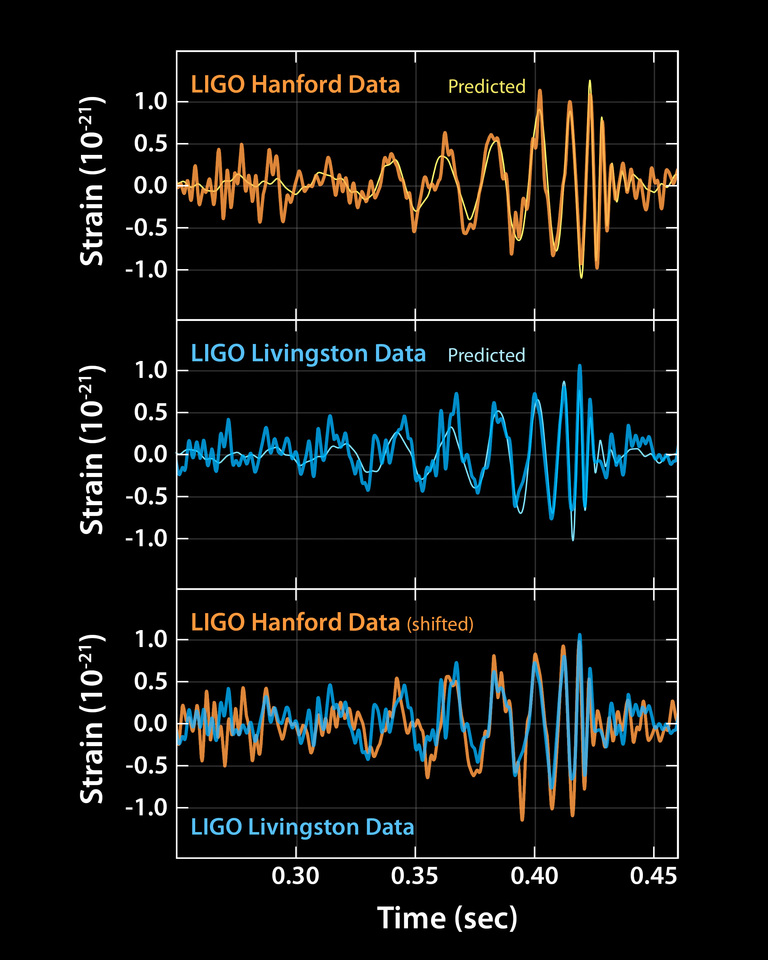
Comparing Numerical Relativity with LIGO Data
The top two plots show data received at Livingston and Hanford, along with the predicted shapes for the waveform. These predicted waveforms show what two merging black holes should look like according to the equations of Albert Einstein's general theory along with the instruments’ ever-present noise. The plots reveal just how closely the LIGO data match Einstein’s predictions.
When the results came in, the match between our signal and what relativity said the signal should look like was breathtaking, as illustrated in the image at right. This was the moment when we could definitively say that we had discovered gravitational waves as Einstein had predicted.
Even when this process was complete, all 1000+ members of the LIGO Collaboration were still forbidden from revealing the discovery to anyone outside of LIGO until the paper describing the discovery was officially published. Nevertheless, despite our best efforts, some rumors leaked out shortly after the actual detection, but they didn’t get very far. Most staff handled those in stride, carefully sidestepping questions from friends and family or the public, or employing clever diversions to change the subject in exchanges that would go something like this:
Friend: “Hey! I’ve heard a rumor that you guys have detected gravitational waves. Is that true?!?!”
Me: “Yeah I've heard that rumor. Wanna hear another one? Some people think we’re beaming things from one end of the arms to the other, like in Star Trek. We hear all kinds of rumors...... <Short uncomfortable silence> ..... So, what are your plans for the weekend?”
Crisis averted!
Questions from the scientific community were a little more difficult to deflect. The typical response was, “we are still analyzing the data; it takes time!”
While this was the truth, it was not always believed.
Making it Official
Between November and the middle of January, members of the LIGO Scientific Collaboration (LSC) wrote the article describing the discovery. On January 21, the paper was completed and submitted to the journal, Physical Review Letters.
One would think this would be a time for LSC scientists to relax and celebrate. In fact, it was the opposite. Simply submitting a paper to a journal doesn’t guarantee its acceptance for publication. First it must be peer-reviewed—a process whereby anonymous expert scientists, unrelated to the LIGO Collaboration, read and scrutinize every word, image, calculation, and conclusion contained within a paper. This ensures that it represents sound science, that it communicates its message clearly, and that the conclusions claimed in the paper can actually be drawn from the evidence presented. In short, they check your homework. If something was wrong with LIGO’s analysis or conclusions, the reviewers would most certainly find it, and LIGO’s historic claims would be debunked. (Given the possible significance of LIGO’s discovery, the reviewers were also required to keep the contents of the paper confidential until the review process was over and any official public announcement was made.)
By this time, the National Science Foundation had scheduled the announcement press conference for February 11, but LIGO was still prepared to call it off if the reviewers responded negatively or had questions needing more time to answer. Thankfully, we didn’t have to wait too long to decide whether to proceed with the announcement, or postpone it.
On January 28th, much to the relief and delight of everyone involved, the reviewers’ feedback was in, and it was resoundingly positive, enthusiastic, and even congratulatory. The analyses were sound, the work was thorough, and the conclusions undeniable. Finally, LIGO had the go-ahead to share its accomplishment with the world.
Three short weeks after the paper was submitted for review, and 150 long days after the detection occurred, that moment came. On February 11, 2016, at 10:30 a.m. Eastern, during a press conference at the National Press Club in Washington DC, Dr. France Cordova, Director of the National Science Foundation, addressed the audience with a broad smile, described the NSF’s 40-year long history of supporting LIGO and its related science and engineering, and then introduced LIGO Executive Director, Dr. Dave Reitze. The room fell silent…and history was made:
“Ladies and gentlemen…
WE DID IT!”
Post Script: A Day (and a Year) to Remember
Since that historic first detection, LIGO has confirmed a second binary black hole merger. While LIGO scientists were busy writing the detection paper for Physical Review Letters, another gravitational wave was detected on Christmas Day. The details of that event would not be released until June 15, 2016, having been scrutinized as closely as the first detection.
In a way, the second detection was equally as important as the first since it verified that what LIGO detected in September wasn’t just a fluke. The second detection meant that the era of gravitational wave astronomy is truly upon us.
While today we celebrate the first detection and reflect on that day and the months that followed, we also look forward to the future. With the second detection, LIGO has firmly planted the seed to achieving its goal of becoming an astronomical observatory. That seed will grow and flourish as more and more detections are made and our “Electromagnetic partners” (astronomical observatories most people are familiar with) catch a flash of light or some other electromagnetic signal (radio wave, gamma ray, x-ray, etc.) caused by a gravitational wave-generating event. That moment will represent LIGO’s next big first.
Additional Resources
- In June, 2016, the World Science Festival held a public lecture with a panel of prominent LIGO scientists. Moderated by author, Brian Greene, panelists shared their perspectives on what it was like to be on the inside of this exciting discovery before it was announced to the world. Click HERE to watch the delightful and often amusing discussion.
- For a timeline of events related to the detection, visit LIGO Magazine Issue 8 March 2016
- Watch the February 11, 2016 announcement press conference


